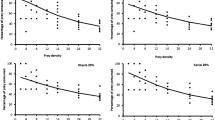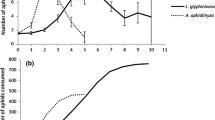Abstract
Herbivore feeding on host plants may induce defense responses of the plant which influence other herbivores and interacting species in the vicinity, such as natural enemies. The present work evaluated the impact of pre-infestation with the tobacco whitefly Bemisia tabaci cryptic species MEAM 1, on the predation ability of the ladybird Propylea japonica, to the green peach aphid Myzus persicae, on tomato plants. The results show that B. tabaci pre-infestation density, duration, and leaf position, can impact prey consumed by P. japonica under various aphid densities. The aphids consumed by P. japonica in each treatment were fit using the Holling type II functional response equation. The predatory efficiency (a/T h) of P. japonica was the highest in the treatment with 60 aphids and 48-h infestation directly on damaged leaves. The predatory efficiencies of P. japonica decreased with a reduction of pre-infestation density and duration. We also observed that pre-infestation on young and undamaged leaves increased predation by P. japonica.




Similar content being viewed by others
References
Agelopoulos N, Keller M (1994) Plant-natural enemy association in the tritrophic system Cotesia rubecula-Pieris rapae-Brassicaceae (Cruciferae): II. Preference of C. rubecula for landing and searching. J Chem Ecol 20:1735–1748
Allen P, Bennett K (2010) PASW statistics by SPSS: a practical guide, version 18.0. Cengage Learning, South Melbourne
Altieri M (1999) The ecological role of biodiversity in agro ecosystems. Agr Ecosyst Environ 74:19–31
Ament K, Kant M, Sabelis M, Haring M, Schuurink R (2004) Jasmonic acid is a key regulator of spider mite-induced volatile terpenoid and methyl salicylate emission in tomato. Plant Physiol 135:2025–2037
Baldwin I (1998) Jasmonate-induced responses are costly but benefit plants under attack in native populations. PNAS 95:8113–8118
Bezemer T, van Dam N (2005) Linking aboveground and belowground interactions via induced plant defenses. Trends Ecol Evol 20:617–624
Bonsall M, Hassell M (1997) Apparent competition structures ecological assemblages. Nature 388:371–373
Byrne D, Bellows T Jr (1991) Whitefly biology. Annu Rev Entomol 36:431–457
Chu D, Zhang Y, Cong B, Xu B, Wu Q (2004) The invasive mechanism of a worldwide important pest, Bemisia tabaci (Gennadius) biotype B. Acta Ento Sini 47:400–406 (in Chinese)
Cohen J, Jonsson T, Carpenter S (2003) Ecological community description using the food web, species abundance, and body size. PNAS 100:1781–1786
Cottenie K (2005) Integrating environmental and spatial processes in ecological community dynamics. Ecol Lett 8:1175–1182
De Clercq P, Mohaghegh J, Tirry L (2000) Effect of host plant on the functional response of the predator Podisus nigrispinus (Heteroptera: Pentatomidae). Bio Control 18(1):65–70
Denno R, Peterson M, Gratton C, Cheng J, Langellotto G, Huberty A, Finke D (2000) Feeding-induced changes in plant quality mediate interspecific competition between sap-feeding herbivores. Ecology 81(7):1814–1827
Dicke M, Baldwin I (2010) The evolutionary context for herbivore-induced plant volatiles: beyond the ‘cry for help’. Trends Plant Sci 15:167–175
Dicke M, Bruin J (2001) Chemical information transfer between wounded and unwounded plants: backing up future. Biochem Syst Ecol 29(10):1103–1113
Dicke M, van Poecke R (2002) Signaling in plant-insect interactions: signal transduction in direct and indirect plant defence. In: Scheel D, Wasternack C (eds) Plant signal transduction. Oxford University Press, Oxford
Emden H, Eastop V, Hughes R, Way M (1969) The ecology of Myzus persicae. Annu Rev Ento 14:197–270
Fernández-arhex V, Corley JC (2003) The functional response of parasitoids and its implications for biological control. Biocontrol Sci Tech 13(4):403–413
Frank S (2010) Biological control of arthropod pests using banker plant systems: past progress and future directions. Biol Control 52:8–16
Gazori F, Hesaaraki M (2015) Mathematical analysis of a within-host model of malaria with immune effectors and Holling type II functional response. Appl Math 42(2–3):137–158
Gencer N, Kumral N, Sivritepe H, Seidi M, Susurluk H, Senturk B (2009) Olfactory response of the ladybird beetle Stethorus gilvifrons to two preys and herbivore-induced plant volatiles. Phytoparasitica 37:217–224
Gurr G, Kvedaras OL (2010) Synergizing biological control: scope for sterile insect technique, induced plant defences and cultural techniques to enhance natural enemy impact. Bio Control 52(3):198–207
Hanselman D, Littlefield BC (1997) Mastering MATLAB 5: a comprehensive tutorial and reference. Prentice Hall PTR, Upper saddle river
Hassell M, Southwood T (1978) Foraging strategies of insects. Annu Rev Ecol S 9:75–98
Hodek I, Honek A (1996) Ecology of coccinellidae. Kluwer Academic Publishers, Netherland
Hodek I, Honek A, van Emden H (2012) Ecology and behaviour of the ladybird beetles (Coccinellidae). Wiley-Blackwell, Oxford
Holling CS (1965) The functional response of predators to prey density and its role in mimicry and population regulation. Memo Entomol Soc Can 97(S45):5–60
Holling CS (1966) The functional response of invertebrate predators to prey density. Memo Entomol Soc Can 98(S48):5–86
Howe G, Jander G (2008) Plant immunity to insect herbivores. Annu Rev Plant Biol 59:41–66
Huang N, Enkegaard A, Osborne L, Ramakers P, Messelink G, Pijnakker J, Murphy G (2011) The banker plant method in biological control. Crit Rev Plant Sci 30:259–278
Inbar M, Gerling D (2008) Plant-mediated interactions between whiteflies, herbivores, and natural enemies. Annu Rev Ento 53:431–448
Kogan M (1998) Integrated pest management: historical perspectives and contemporary developments. Annu Rev Ento 43:243–270
Kost C, Heil M (2006) Herbivore—induced plant volatiles induce an indirect defence in neighbouring plants. J Ecol 94(3):619–628
Lin KJ, Wu KM, Liu SB, Zhang YJ, Guo YY (2006) Functional responses of Chrysopa sinica, Propylaea japonica and Leis axyridis to Bemisia tabaci. Chin Bull Ento 43:339–343
Liu TX, Stansly P (2002) Functional response and plant preference of Nephaspis oculatus (Coleoptera: Coccinellida), preying on Bemisia argentifolii (Homoptera: Aleyrodidae) in the laboratory. Entomol Sini 9:1–10
Mandour N, El-Basha N, Liu TX (2006) Functional response of the ladybird, Cydonia vicina nilotica to cowpea aphid, Aphis craccivora in the laboratory. Insect Sci 13:49–54
Maurhofer M, Hase C, Meuwly P, Metraux J, Defago G (1994) Induction of systemic resistance of tobacco to tobacco necrosis virus by the root-colonizing Pseudomonas fluorescens strain CHA: influence of the gacA gene and of pyoverdine production. Phytopathology 84:139–146
Mauricio R (2000) Natural selection and the joint evolution of tolerance and resistance as plant defenses. Evol Ecol 14:491–507
Mohaghegh J, De Clercq P, Tirry L (2001) Functional response of the predators Podisus maculiventris (Say) and Podisus nigrispinus (Dallas) (Het., Pentatomidae) to the beet armyworm, Spodoptera exigua (Hubner) (Lep., Noctuidae): effect of temperature. J Appl Entomol 125(3):131–134
Pianka E, May R (1981) Competition and niche theory. Theor Ecol 7:167–196
Price P (1986) Ecological aspects of host plant resistance and biological control: interactions among three tropical levels. In: Boethel D, Eikenbary R (eds) Interactions of plant resistance and parasitoids and predators of insects. Ellis Horwood, Chichester
Rogers D (1972) Random search and insect population models. J Anim Eco 41:369–383
Sabelis M, Janssen A, Kant M (2001) The enemy of my enemy is my ally. Science 291:2104–2105
Schilmiller A, Howe G (2005) Systemic signaling in the wound response. Curr Opin Plant Biol 8:369–377
Stratmann J (2003) Long distance run in the wound response—jasmonic acid is pulling ahead. Trends Plant Sci 8:247–250
Tan XL, Liu TX (2014) Aphid-induced plant volatiles affect the attractiveness of tomato plants to Bemisia tabaci and associated natural enemies. Entomol Exp Appl 151:259–269
Tan XL, Ridsdill-Smith J, Liu TX (2014) Direct and Indirect Impacts of Infestation of tomato plant by Myzus persicae (Hemiptera: Aphididae) on Bemisia tabaci (Hemiptera: Aleyrodidae). PLoS ONE 9:e94310. doi:10.1371/journal.pone.0094310
Tan XL, Hu NN, Zhang F, Ramirez-Romero R, Desneux N, Wang S, Ge F (2016) Mixed release of two parasitoids and a polyphagous ladybird predator to suppress the tobacco whitefly Bemisia tabaci (Hemiptera: Aleyrodidae). Sci Rep 6:28245. doi:10.1038/srep28245
Varley GC, Gradwell GR, Hassell MHP (1974) Insect population ecology: an analytical approach. University of California, Princeton
Vet L, Dicke M (1992) Ecology of info chemical use by natural enemies in a tritrophic context. Annu Rev Ento 37:141–172
Xue M, Wang C, Bi M, Li Q, Liu TX (2010) Induced defense by Bemisia tabaci biotype B (Hemiptera: Aleyrodidae) in tobacco against Myzus persicae (Hemiptera: Aphididae). Environ Ento 39:883–891
Acknowledgement
Support of this research was from the following Grants: the National Natural Science Foundation of China (NO. 31272089), National Basic Research Program of China (973 Project No. 2013CB127600), Beijing Technology Program (D171100001617003) and Youth Science Foundation, Beijing Academy of Agriculture and Forestry Sciences (No. qnjj201410). We are grateful for the assistance of all staff and students in the Key Laboratory of Applied Entomology, Northwest A&F University at Yangling, Shaanxi, China.
Author information
Authors and Affiliations
Corresponding author
Additional information
Handling Editor: Yulin Gao.
Rights and permissions
About this article
Cite this article
Yang, F., Tan, XL., Liu, FH. et al. A functional response evaluation of pre-infestation with Bemisia tabaci cryptic species MEAM1 on predation by Propylea japonica of Myzus persicae on host plant tomatoes. Arthropod-Plant Interactions 11, 825–832 (2017). https://doi.org/10.1007/s11829-017-9537-1
Received:
Accepted:
Published:
Issue Date:
DOI: https://doi.org/10.1007/s11829-017-9537-1




